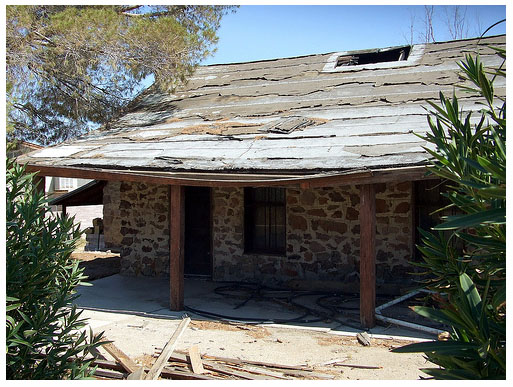Rosamond, Ca. 93560
The Unofficial Website
![]()
Local History - Willow Springs
BEFORE the coming of the railroad, a traveler headed north through the Antelope Valley would likely pass through the small settlement of Willow Springs about 8 miles west of Rosamond. The following AV Press article details a bit of its early history:
(AV
Press April 8, 2010)
ROSAMOND
- In 1862,
a year after they married in Los Angeles, 23-year-old Nelson Ward and his
14-year-old wife, Adelia, settled next to a brush-covered butte beside one of
the western Mojave Desert's few good sources of water: Willow Springs.
Surrounded by willow bushes that gave them their name, the springs had provided water for Native Americans for centuries. The springs began serving more travelers after a 1850s gold rush on the Kern River, near what is now Lake Isabella, and the arrival in the Owens Valley in the early 1860s of cattlemen supplying newly opened mines along the California-Nevada border.
The Wards - he had emigrated to California from Ohio as a teenager with his father in 1855, she came to California from Boston - built an adobe structure that was called a boardinghouse and kept a number of horse or mule teams, according to "Antelope Valley Pioneers," published in 1984 by the Kern Antelope Historical Society.
'The Wards were gracious hosts," Alan Hensher wrote in "Ghost Towns of the Mojave Desert," published in 1991. "But their station remained cramped. Guests usually slept in the bar - and the pace remained hectic - customers had to gobble down their predawn breakfasts in such haste that the stop was dubbed the 'Hotel de Rush,'" he added.
In the late 1860s, even more travelers, miners and mule teams began stopping at Willow Springs with the discovery of silver at Cerro Gordo, in the Inyo Mountains above Owens Valley. Los Angeles was the Cerro Gordo mines' main supply point, and the silver hauled there would stimulate the tiny town's economy.
Willow Springs became one of the stops for mule-drawn freight wagons belonging to the Cerro Gordo Freighting Company, operated by Los Angeles freighter Remi Nadeau in partnership with Cerro Gordo mine owners Victor Beaudry and Mortimer Belshaw.
"Eventually 80 teams of three wagons, each pulled by 16 mules, hauled bars of silver bullion from the smelter at the shore of Owens Lake to the port at San Pedro. Each round trip took eight to nine weeks," according to Bureau of Land Management geologist Larry M. Vredenburgh, who writes about the history of mining in the Mojave Desert. "Between Cerro Gordo and Los Angeles a dozen stations were established at regular intervals, a day's haul which varied from 13 to 20 miles.'
Some stations were operated by Nadeau's company, and some were independents, like Willow Springs. There were two stations in Soledad Canyon, then one at Barrel Springs just south of present-day Palmdale, then another at a place called Cow Holes, then Willow Springs. North of Mojave was a station called Forks of the Road near the present-day Randsburg Cutoff from Highway 14 where southbound travelers could veer off toward Tehachapi.
Besides Nadeau's mule teams, stagecoaches and individuals traveling between the Owens Valley and Los Angeles also used Willow Springs.
"The brush and adobe stations provid(ed) rough meals," wrote Neill Wilson in 'Silver Stampede’, published in 1937. As for beds, "Take your pick o' the sagebrush stranger. Our rooms are never full.'"
An 1874 traveler reported: "At the springs, hay is sold at 2 1/2 cents and grain at 3 1/2 cents per pound."
Nelson Ward died in 1873, leaving his 25-year-old widow with five children and the Willow Springs station. Two years later, the station lost the Cerro Gordo freight business, when Nadeau shifted his mule-team route to join the new railroad line that had inched its way east over the Tehachapi Mountains and was due to reach the Antelope Valley and Los Angeles the next year.
When Nadeau shifted his freight route, Adelia Ward moved out of Willow Springs and opened a hotel in Greenwich, a short-lived settlement on the new railroad line west of present day Tehachapi.
In 1878, she remarried and began running a hotel at Tehachapi Summit, now known just as Tehachapi. She died in 1881.
Meanwhile, the Willow Springs station was taken over by a couple named Riley, who in November 1875 had the bad fortune to be robbed by surviving members of Tiburcio Vasquez's gang.
"After having tied up the only men there, Mr. Riley, the station keeper and George Decker, a teamster, they proceeded to go through the station, helping themselves to whatever they fancied, and a foolish traveler approaching was relieved of $70," the Los Angeles Star reported.
"They ended up by appropriating Decker's team and starting for the mountains. They offered no personal violence beyond tying up the men," the newspaper added. "Riley's wife was not molested."
The following August, the railroad tracks reached Mojave. A month later, in September 1876, the tracks to Los Angeles were completed through Soledad Canyon, making long-distance stagecoach travel across the Valley obsolete. The Wards' adobe building was a ruin by the mid-1880s.
In 1900, Los Angeles clayware factory owner Ezra Hamilton, who four years earlier had found gold on a nearby butte and opened what became the Tropico mine, bought Willow Springs and the surrounding 160 acres. He built new stone buildings and turned the property into a resort, with swimming pool and dance hall. The stone buildings still exist (photo above), but the original adobe stage station is gone.
Compiled by AV Press Managing Editor Charles F. Bostwick. ©2010 AV Press
